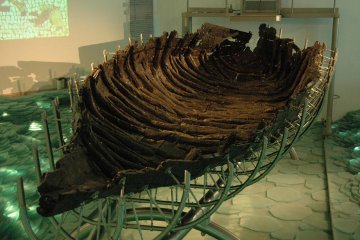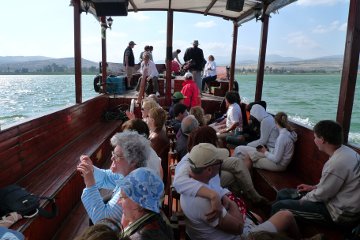The "Jesus Boat"
| Kibbutz Ginnosar | 32 50 39.12N 35 31 30.85E | The circular building by the shore of the lake is the museum which houses the "Jesus Boat". |
There may be many authorities on new boats but there are not that many authorities on old boats, that is, really old boats. Professor Shelley Wachsmann however is such an authority, and he recently delivered a lecture at Sydney University on the 1986 discovery and subsequent preservation of the boat found in the Lake of Galilee. The boat is 2000 years old and comes from the time of Jesus, which is why many refer to it as the "Jesus Boat".

| |
| The "Jesus Boat" after restoration and preservation is on display in a purpose-built museum at Kibbutz Ginnosar. |
In 1986 an Israeli man by the name of Uval from the nearby Kibbutz Ginosar was out for a walk. There had been a very low rainfall that year and the level of the lake was unusually low. As Uval wandered over the muddy flat left by the receding water his eyes suddenly spotted something unusual. There were some old pieces of wood protruding from the mud and Uval noticed that they formed the rough outline of the shape of a boat. Uval had had a lot of experience with boats. He knew one when he saw one.
There was no time to lose. At any moment more rain might come and the mud flat would be once more submerged beneath the water. He hastily reported his find to the authorities and members of the Israel Antiquities Department were soon on the site. As Shelley was the ultimate authority on old boats he was called to the scene and supervised the rescue operation.
Professor Shelley Wachsmann served as Inspector of underwater antiquities for Israel from 1976 to 1989, supervising many surveys and excavations in the Sea of Galilee, the Red Sea and the Mediterranean Sea. His activities included a search for cannon jettisoned by Napoleon during his retreat from Acre in 1799. He was involved in the 1999 Ashkelon Deep-Water Survey which examined two Phoenicians ships that were wrecked in the eighth century BC. They were at a depth of about 500 metres (1640'). So he knew how to go about things when he was called to this delicate task.
The major problem the rescuers faced was the preservation of the wood from which the boat was made. Because it had been submerged beneath the mud for 2,000 years, this had preserved it, but the wood had the consistency of wet cardboard. Shelley knew that exposure to air would cause havoc, but the boat being so fragile, it could not immediately be lifted out of its muddy bed and transported to the artificial bath it needed. They decided that polyurethane was the answer.
The news spread like wildfire and caught the imagination of people everywhere. Newspapers all over the world carried the story, and volunteers flocked to the site. Carefully they scooped the mud from inside the boat while volunteers gently hosed the wood to keep it wet. The polyurethane was then sprayed against the inside timbers to preserve them from the elements.
Tunnels were dug underneath the boat and the holes were also filled with the synthetic material. At last the boat was entirely smothered. Then came the task of transporting it to the kibbutz. That was not easily done either. A helicopter offered its services but they concluded that the possible vibrations would be detrimental to the boat. Finally they decided to float it to its destination. They cut a channel to the boat and waded around, steering the boat to its destination.
An oblong bath was quickly built to hold the boat and this was filled with water. After the boat was safely inside, a shed was built around it. (Some visitors look at the shed and naively ask, "How did you get the boat through the door?"). Appropriate minerals were then added to the water - and changed from time to time - and the boat was left there for ten years while the minerals and chemicals in the bath permeated the timbers leaving the boat as a virtual fossil. It has now been dried out and put on display.
The next question was to examine the features of the boat to determine its age. The wooden pieces were held together by mortise and tenon joints, a method that was used 2,000 years ago. Radiocarbon dating also confirmed the approximate date. The style of the boat also testified to its age. Archaeologists determined that this was indeed a boat from the time of Jesus.

| |
| Members of my tour group enjoy a ride on a modern "Jesus Boat" as we head across Galilee from Ein Gev to Ginnosar. |
Research was then done on the capacity of such a boat in Jesus' day. A mosaic from a later period depicted four men manning the oars, and some historic statements also mention a crew of four. Comments made by the Jewish historian Josephus, who lived in Israel at that time, mentioned up to twelve people being in boats on the lake, and one historian even mentioned fifteen. So it would have been quite possible that at that time there were boats capable of carrying Jesus and his twelve disciples.
There are many incidents recorded in the gospels and Shelley claimed that he had read them over and over again many times to make sure he was getting all the relevant information that could be gleaned from the Gospel stories. John's boat was used for fishing, by Jesus as a pulpit, and for transporting him across the lake. Putting it all together he concluded that the record was perfectly plausible.
No one is suggesting that this was the very boat that Jesus' disciples owned and used, but it can be said that it must have been typical of the boat they used. Anyway the idea has since caught on and there are now several modern boats plying the lake for tourists. One is called Matthew, another Luke and still others are called Mary and Martha. They have been built twice the size of the Jesus boat but to the same scale, so pilgrims and tourists can feel the atmosphere.
Our annual tour to Israel includes a trip across the lake and we hire a "Jesus Boat" for the occasion. Of course no one thinks that they are recreating a trip that Jesus might have taken - the noise of the diesel engine is too loud for that - but it is still a special and exciting part of the tour, especially if the wind has risen and the sea is choppy. Click here for information about our latest tours.





